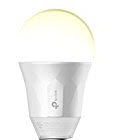 If you are thinking of automating the lighting in your home then this starter guide will hopefully help you understand your options and give an idea as to how much it will cost.
If you are thinking of automating the lighting in your home then this starter guide will hopefully help you understand your options and give an idea as to how much it will cost.
Eventually new homes and buildings with be built with smart lighting, but until then most homes will be retrofitted.
Smart Home Lighting Design Options
When developing smart home lighting there are several design options you can choose.
You can adopt current lighting control norms ; which is wall switches in fixed locations.
Alternatively you could go for a no switch option and have everything controlled via a smart phone, Alexa/Siri or even mobile switches that you can stick on a wall anywhere and move when needed.
Control Using Fixed Wall Switches as Per Today’s Norm
The main advantage of this design is that it is easily understood by visitors and by potentially new owners when selling the home.
This doesn’t mean that the switches can’t be smart switches but it does mean that there is a physical switch that turns a light on/off.
You can also control the lights using a mobile phone App,Alexa/Siri or by presence sensors etc.
No Switch Control Design Option
The advantage of this option is that you have no wall switches and hence no wiring to wall sockets.
Lights are controlled by a mobile phone App,Alexa/Siri or by presence sensors etc.
Mobile switches can be placed in rooms, but they might be confusing.
The big disadvantage is that it is unfamiliar to most and how do guests control lights that they need, and how would a potential home buyer react to such a design.
Lighting Control Options
These are the options for standard wired lighting currently controlled by a wall mounted switch as shown in the diagram below.
s
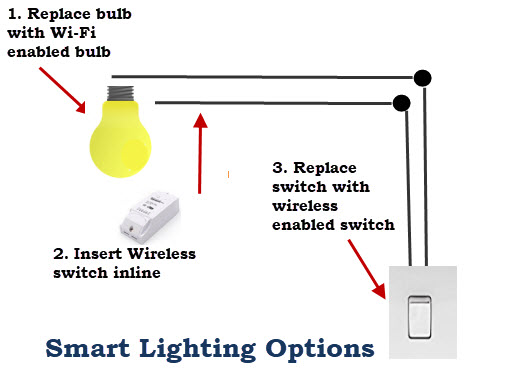
We can
- Change the existing bulb for a Wireless enabled Light Bulb and Keep the existing switch.
- Keep the existing bulb and switch but Insert a Wireless switch in line. This can be behind the switch or anywhere in the circuit between the bulb and switch.
- Keep the existing bulb and change the existing switch to a Wireless enabled switch.
Bulbs with Wi-fi or Zigbee Embedded
Technology & Control
These Bulbs are equipped with Wi-Fi or ZigBee and can be controlled by a variety of devices e.g. Mobile App on Android and IOS or home automation system, Amazon echo, Google Home etc
Hub Required
Yes for ZigBee or Zwave , and no for Wi-Fi
Advantages
- Easy to install
- No changes to existing wiring
Disadvantages
- Costly bulbs cost approx $8 -$20 but vary considerably.
- May not work with dimmers.
- May not work with all light fittings e.g. candle fittings.
- You have to leave light switch on permanently.
Light Switch Types
There are two main types:
- Hard wired switches that are wired as per normal switches but also have a wireless transmitter/receiver.
- Wireless switches that don’t require mains wiring but send signals using some form of wireless. They are usually battery operated, and some can be attached to a wall using sticky pads as they are lightweight.
Wireless Technologies Involved
Most Home smart lighting devices use some form or Wireless. The most common being:
- Wi-FI
- ZigBee
- Zwave
- RF433Mhz
Using Hard Wired Switches With Wireless
These replace the existing hard wired switch. They are wired exactly the same as the existing switch and can be use just like the existing switch.
However because they have a built in wireless transmitter/receiver they can also be controlled remotely. A example is shown below:
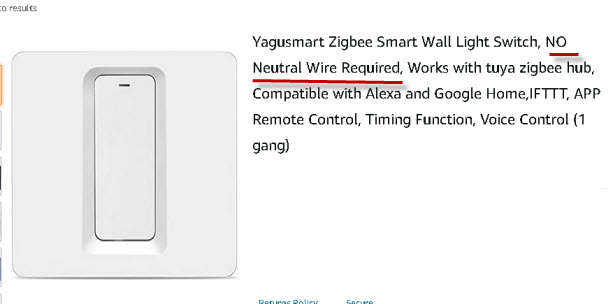
Note that this is a UK switch and that it doesn’t require a neutral wire which is standard in the UK. If you are in the UK you should always check this.
The switch uses Zigbee and requires a hub to connect to the Internet and Tuya.
You need to pay special attention to this as although you can control these switches using node-red, homeassistant and other home automation systems the setup isn’t as easy as using the official application .
Therefore if you are non technical and want an easy solution you should always choose devices from the same brand.
These switches are an ideal drop in replacement for an existing switch even if the switch operates as a two way switch. For a new build I wouldn’t use this option as it involves additional wiring to the switch.
Advantages
- Easy to install in an existing installation
- Makes a simple switch smart.
- Gives local control even if the hub etc fail.
Disadvantages
- Not so easy to install in a new build and uses more cable and takes more time.
- Requires the same cabling as standard wired circuit used today.
Wall Wireless Only Switches
These are wall mounted battery operated switches that also require a receiver in the switch line that does the actual switching.
Note: Kinetic switches are available that don’t require a battery.
An example is shown below:
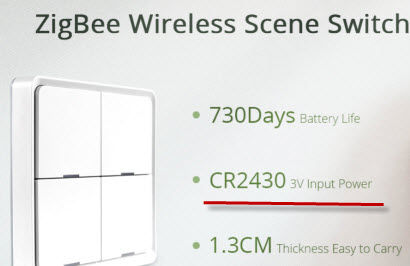
Notice it uses a battery so no wiring is required. You can carry it around or stick it on the wall just like a normal switch.
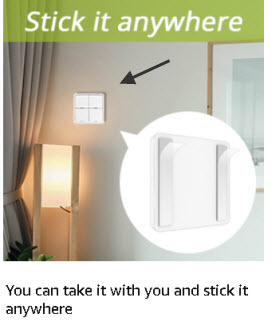
The switch as it stands isn’t enough to turn the lights on and off. You need an in line switch to do this as shown in the diagram below:
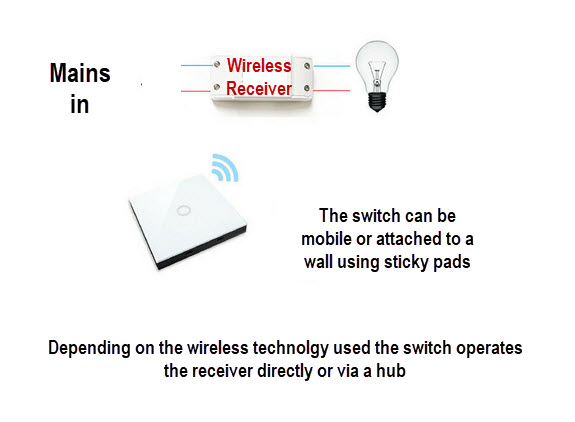
These switches are usually Wi-Fi, Zigbee or Proprietary RF (433Mhz)
Some of these receivers use two wireless technologies as shown in the diagram below.
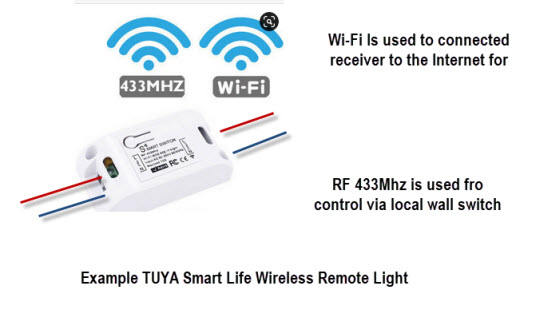
This video shows how to Install a wireless switch
Control Device
Most can be controlled by a Mobile App on Android and IOS or home automation system, Amazon echo, Google Home etc
RF switches doesn’t require use of phone/tablet and are ideal for the elderly and can comprise a Physical switch which can be carried around.
Hub Required
No with Wi-fi, Yes for Zibee and Zwave
Advantages
- Not restricted to lighting
- Can be used to easily add another light switch in a more convenient location.
- Works with all light fittings e.g. candle fittings
Disadvantages
- Receiver needs to be Installed.
- Have to leave an existing light switch on permanently so that it can be controlled so not really suitable to replace an existing wired switch unless you change the wiring.
- RF433Mhz wireless cannot be controlled via the home network and not considered smart but very useful in homes that don’t have Wi-fi and the Internet i.e usually for elderly.
- Need to change battery
My Opinion
Wireless only switches are ideal for a new build or when carrying out extensive rewiring.
Because the switch doesn’t need wiring it can save a lot of money for installation, and also make the system very flexible as the switches are easily moved.
I would avoid those that also require mains power but don’t use a mains switch to the light.
Hard Wired Wireless switches are an ideal drop in replacement for an existing switch making it smart.
When using technologies like Zigbee they (wireless only and hard wired) can easily be reconfigured to work with other lights and appliances and to control multiple lights etc
Very low cost RF433 wireless in line switches are likely to become popular in non smart home installations especially for the elderly.
Because smart bulbs are expensive and bulbs are consumable items I don’t expect that they will be as popular as smart switches and in line switches.
Important Considerations for UK
The UK uses a two wire lighting system.Some switches require a neural and so will not work in a two wire system.
This article- Understanding 2 and 3 wire lighting systems explains this very well
Home Lighting Automation Systems
The ability to turn on/off a light remotely or without wires isn’t automation.
Automation involves the automatic turning on/off of lights in response to certain events.
In order to do this you will require some form of home automation system.
You can build this yourself using node-red for example, but most will opt for a pre-designed system like homeassistant, Amazon echo, Google home etc.
References
Related Tutorials
- Controlling Smart Home Devices
- Smart Home Hubs,Gateways and Systems -Beginners Guide
- Zigbee Networking Basics